Introduction
In the rapidly evolving landscape of software development, the adoption of Continuous Integration (CI) and Continuous Deployment (CD) practices has emerged as a critical strategy for organizations aiming to enhance their operational efficiency and software quality. These methodologies not only facilitate the seamless integration of code changes but also streamline the deployment process, ensuring that software updates are delivered swiftly and securely.
As companies increasingly recognize the importance of these practices, understanding the intricacies of CI/CD pipelines becomes essential. This article delves into the fundamental components of CI/CD, outlines best practices for implementation, and highlights the significance of integrating automated testing to bolster software reliability.
By exploring these elements, organizations can position themselves for success in an increasingly competitive digital environment.
Understanding CI/CD Pipelines: An Overview
Continuous Integration (CI) and Continuous Deployment (CD) are essential methods in building CI/CD pipelines that enable organizations to streamline their development processes through frequent code modifications and automated deployments. CI concentrates on the automatic evaluation and integration of code modifications into a shared repository, while CD guarantees these changes are deployed into production environments swiftly and securely. The importance of implementing these practices is highlighted by the fact that 6.8% of companies using DevOps are located in India, indicative of a growing trend in development methodologies.
As emphasized by industry expert Leonardo Bravo, this accumulated experience fosters a deeper understanding of the intricacies of building, testing, and deploying applications. Building CI/CD pipelines through the adoption of continuous integration and delivery not only enhances delivery speed and quality but also minimizes errors, leading to improved customer satisfaction and increased business agility. To attain improved delivery performance, organizations are encouraged to focus on building CI/CD pipelines by utilizing a combination of self-hosted and managed continuous integration and continuous deployment services, which has been associated with superior performance results.
Moreover, the necessity of building CI/CD pipelines that include security tests is emphasized as a critical factor for successful application delivery, enhancing overall quality and security. The recent promotion by the CD Foundation for improved interoperability and secure supply chains further illustrates the changing environment of continuous integration and delivery methods, making it essential for organizations to stay informed and adapt accordingly.
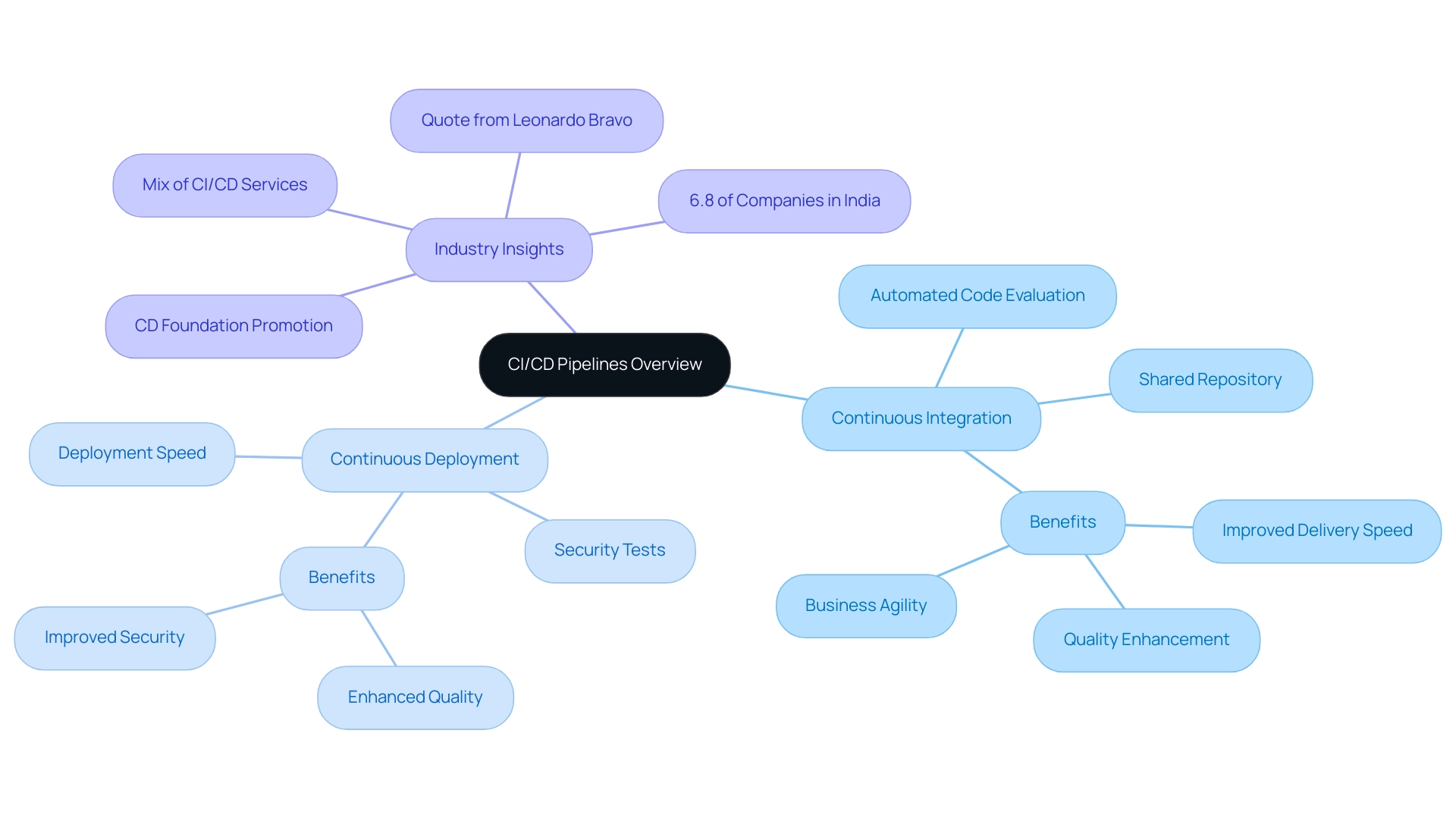
Key Stages of a CI/CD Pipeline: From Code to Deployment
Building CI/CD pipelines involves several essential stages, each contributing to the integrity and quality of the software being developed.
-
Source Code Management: This initial stage involves storing code in a version control system, such as Git, which facilitates collaboration and change tracking among development teams.
-
Continuous Integration: During this phase, code changes are automatically tested and merged into the main branch, ensuring that integration occurs seamlessly and frequently.
This practice significantly reduces integration issues and fosters a more collaborative development environment. -
Build: The build stage compiles the application and resolves dependencies, transforming the source code into a runnable program. This process is crucial as it translates developer intent into an executable product.
-
Automated Evaluation: Comprehensive assessment occurs here, where unit evaluations and integration assessments are executed to validate code quality. Effective automated evaluation is vital; as Gene Kim notes, 'High-performing organizations excel at automated evaluation, leading to faster delivery and improved software quality'. Recent advancements in automated evaluation methods have contributed to more efficient detection of issues, thus enhancing the mean time to detection (MTTD), which measures the time between deployment and issue identification.
For instance, the parallel stage 'js unit tests' takes approximately 3.6 minutes, showcasing the efficiency of automated evaluation in the CI/CD process. -
Deployment: This stage involves deploying the application to production or staging environments, making it accessible for users or further testing. A swift and reliable deployment process is essential for maintaining business agility.
-
Monitoring: Post-deployment monitoring is critical to ensure that the application operates as intended. It enables teams to identify and tackle any problems early, thereby improving overall system reliability. Furthermore, reports from SEI examining changes in Job/Pipeline Config from the Deployment/CICD tool offer valuable insights into the performance and adjustments of continuous integration and delivery processes.
Each stage of building CI/CD pipelines plays a pivotal role in ensuring the software not only meets quality standards but is also delivered reliably to end-users. For instance, a case study titled 'Time to Fix Tests' illustrated that low resolution times for fixing tests indicate effective pipeline use, allowing teams to address issues while they remain fresh. This proactive approach helps prevent the development of additional functionality on unstable code, ultimately enhancing code stability.
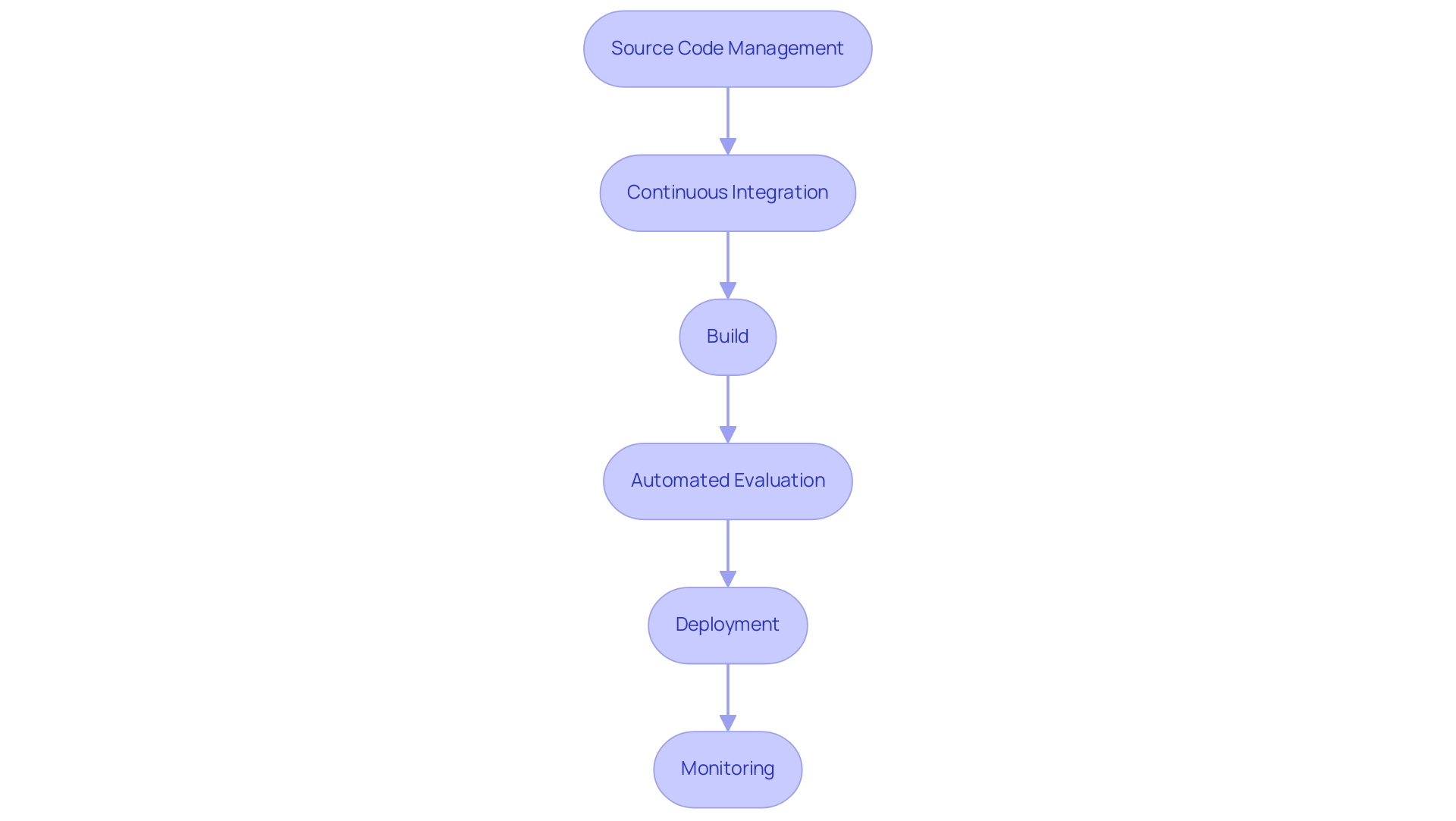
Choosing the Right Tools for Your CI/CD Pipeline
When selecting tools for your CI/CD pipeline, it is crucial to evaluate several key components to tailor an optimal setup for your organization:
- Version Control: Git remains the most widely adopted version control system, known for its flexibility and scalability, making it a reliable choice for teams of all sizes.
- Continuous Integration/Continuous Deployment Platforms: Leading options such as Jenkins, GitLab CI, and CircleCI provide robust automation features. Jenkins is particularly notable for its extensive plugin ecosystem and pipeline-as-code capabilities.
Despite being one of the oldest tools for continuous integration and delivery, Jenkins is experiencing a gradual decline in use, prompting teams to explore alternatives like GitLab CI, which offers seamless integration and a user-friendly interface. According to the State of Developer Ecosystem 2023 report, many organizations are recognizing the urgency to adopt advanced continuous integration and continuous deployment tools, especially low-performing teams that need to focus on building CI/CD pipelines to enhance their development processes.
- Containerization: Tools like Docker streamline the deployment process, enabling teams to create consistent environments for application performance. This not only accelerates deployment cycles but also enhances scalability.
- Monitoring: Implementing monitoring tools such as Prometheus and Grafana contributes to comprehensive application performance tracking, ensuring that any issues are identified and addressed promptly.
It is essential to evaluate each tool based on your organization’s size, project complexity, and specific requirements.
As mentioned by Maarten Balliauw, Developer Advocate at JetBrains:
Ultimately, selecting a continuous integration and delivery platform should be based on your present and expected future requirements.
This customized method guarantees that building CI/CD pipelines is not only effective but also aligned with your long-term strategic goals. The case study on Jenkins illustrates that while it remains popular due to its rich plugin ecosystem and robust pipeline-as-code approach, its declining popularity indicates the need for organizations to consider their future needs and potential alternatives.
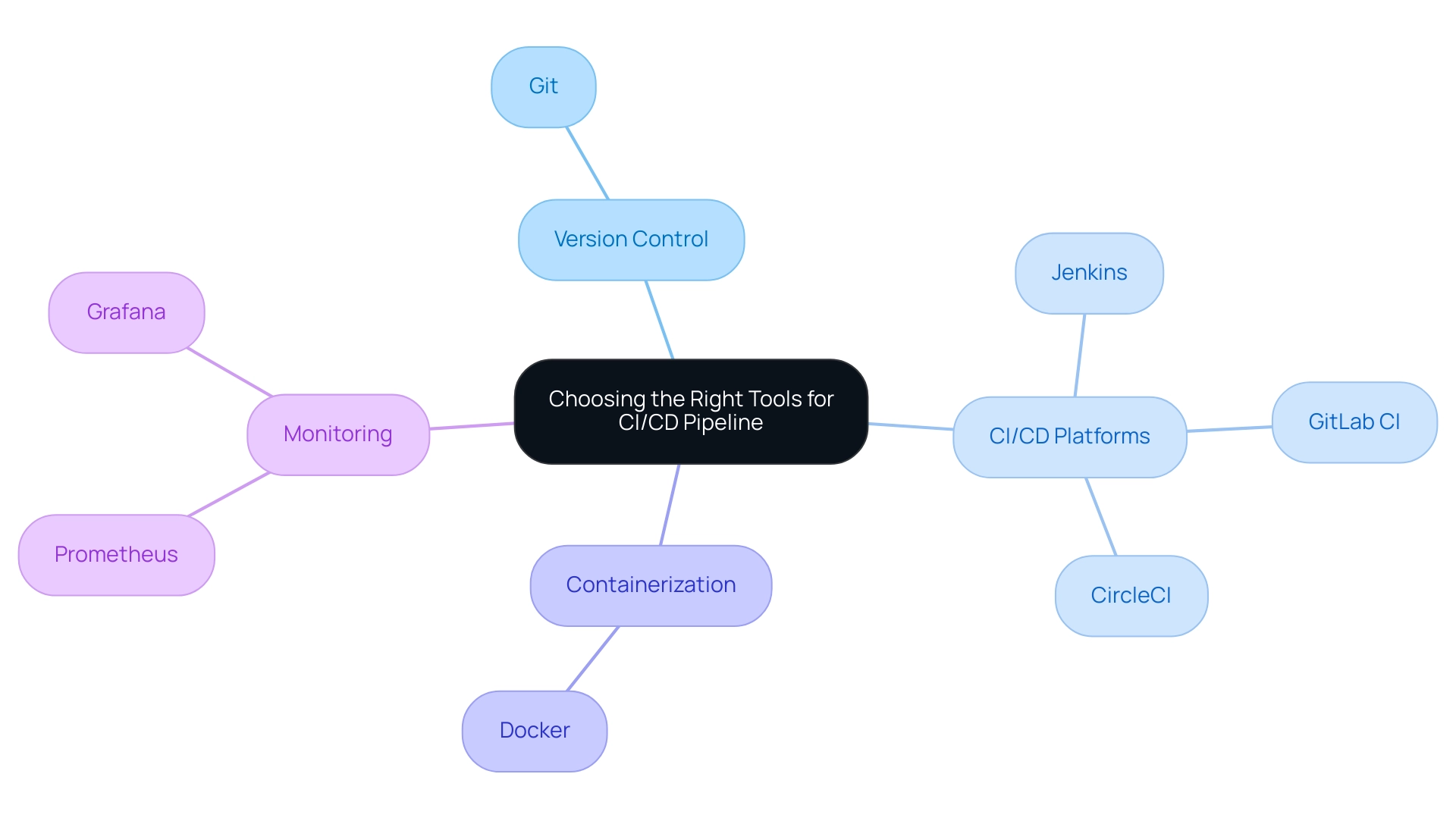
Best Practices for Building Effective CI/CD Pipelines
To create a strong continuous integration and delivery pipeline, follow the subsequent guidelines that align with the most recent standards for 2024:
-
Automate Everything: Implement automation for all stages of the pipeline, from testing to deployment. Automation is essential, as Kelsey Hightower, a prominent thought leader, highlights that building CI/CD pipelines through containerization is a key enabler of optimal approaches, allowing for efficient workload management and preparing for a time where development agility is paramount. Additionally, utilizing tools like Datadog's GitLab integration allows for the collection of runner logs, which can help monitor cleanup job success rates and ensure that automated processes are functioning as intended.
-
Keep It Simple: Simplicity is vital. Avoid introducing unnecessary complexity into your pipeline, as this can lead to increased error rates and longer resolution times.
-
Frequent Commits: Foster a culture where developers commit code frequently. This method significantly reduces integration issues, ensuring smoother collaboration and faster feedback loops. Statistics show that teams practicing frequent commits experience a 30% reduction in integration-related problems, enhancing overall productivity.
-
Monitor and Optimize: Continuous monitoring of pipeline performance is essential. Regularly assess metrics and make necessary adjustments to optimize efficiency and effectiveness. Proper tooling, as highlighted in various case studies, plays an integral role in building CI/CD pipelines, which supports these strategies and enables teams to avoid deviations during product development.
-
Documentation: Comprehensive documentation of pipeline processes and configurations is crucial. This not only assists in onboarding new team members but also guarantees that optimal methods are consistently adhered to.
By following these optimal methods, teams can improve collaboration, streamline their workflows, and minimize the risks linked to deployments. Highlighting appropriate tools, as shown in case studies, is essential for attaining efficient continuous integration and delivery practices.
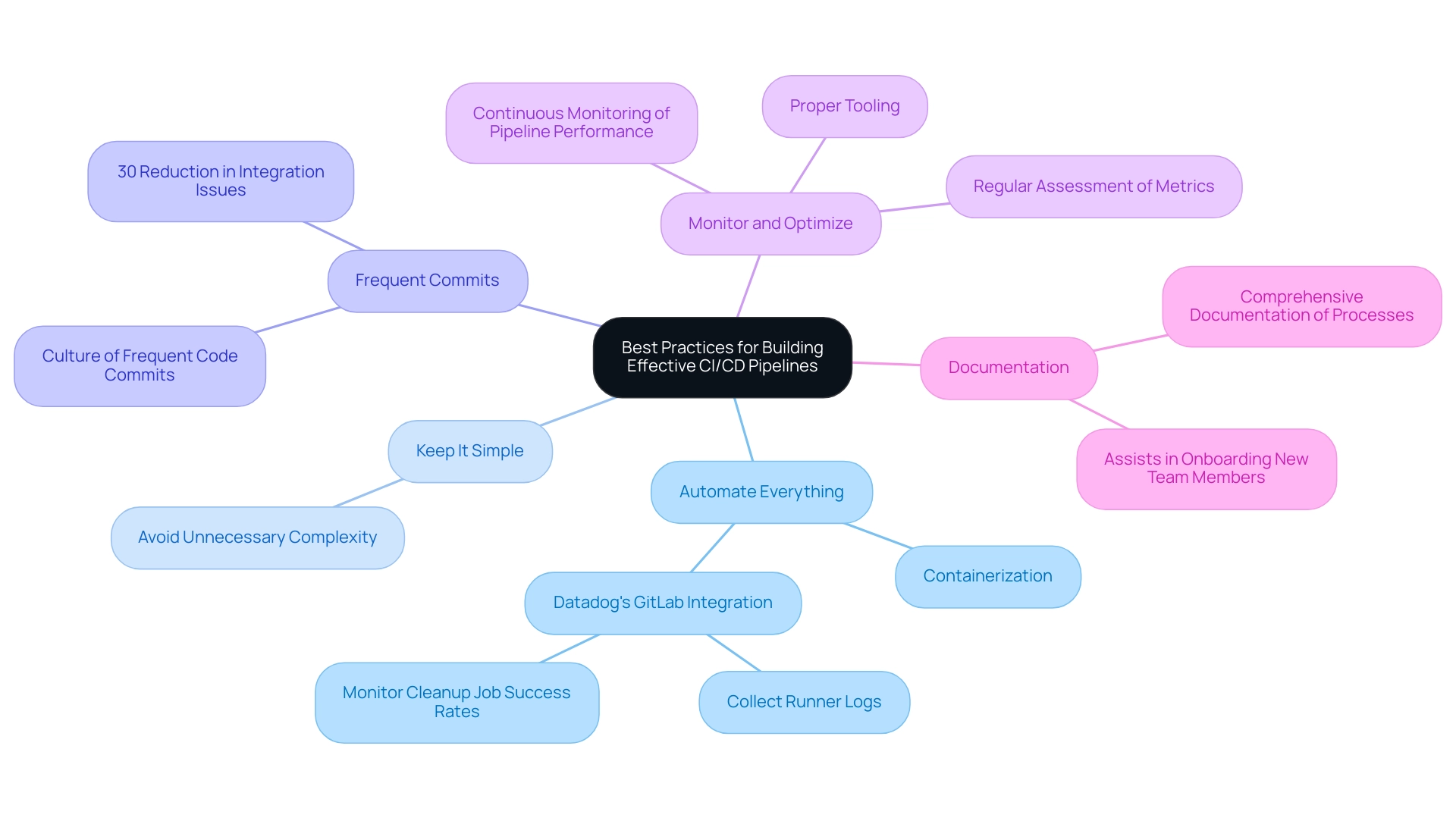
Integrating Automated Testing into Your CI/CD Pipeline
Incorporating automated evaluation into building CI/CD pipelines is crucial for improving software reliability and decreasing defect rates. The subsequent steps offer a structured method to incorporate evaluation into your development process:
-
Select Evaluation Frameworks: It is crucial to choose evaluation frameworks that align with your programming languages. For example, utilize JUnit for Java applications and pytest for Python projects to ensure compatibility and optimize testing efficiency.
-
Define Test Cases: Comprehensive test cases should encompass unit tests, integration tests, and end-to-end tests. This thorough planning addresses various potential failure points and ensures robust coverage.
-
Integrate Testing into the Pipeline: Configure your continuous integration and deployment tools to automatically execute tests at critical stages, particularly after code integration and prior to deployment. This integration minimizes the likelihood of defects reaching production, aligning with recent industry findings that organizations focused on building CI/CD pipelines report 60% higher team efficiency. Furthermore, as emphasized by a study from Google, high-performing DevOps organizations that deploy multiple times daily experience a 7% lower change failure rate than those deploying less often, highlighting the significance of automated evaluation in achieving dependable deployments.
-
Monitor Test Results: Regularly review and analyze test results. Promptly addressing any failures is vital to maintaining the integrity of your pipeline and ensuring timely delivery of high-quality products. The focus on observability as a leading organizational priority is vital here; efficient monitoring of test outcomes not only assists in prompt issue resolution but also improves overall visibility into application performance, thus facilitating quicker digital transformation.
By effectively incorporating automated testing and concentrating on observability, organizations can significantly boost the reliability of their systems, thereby minimizing risk and enhancing overall operational efficiency. Furthermore, implementing best practices for building CI/CD pipelines, as demonstrated in case studies, can lead to increased organizational efficiency and reduced risks associated with software modifications. This approach aligns operational KPIs with overarching business goals.
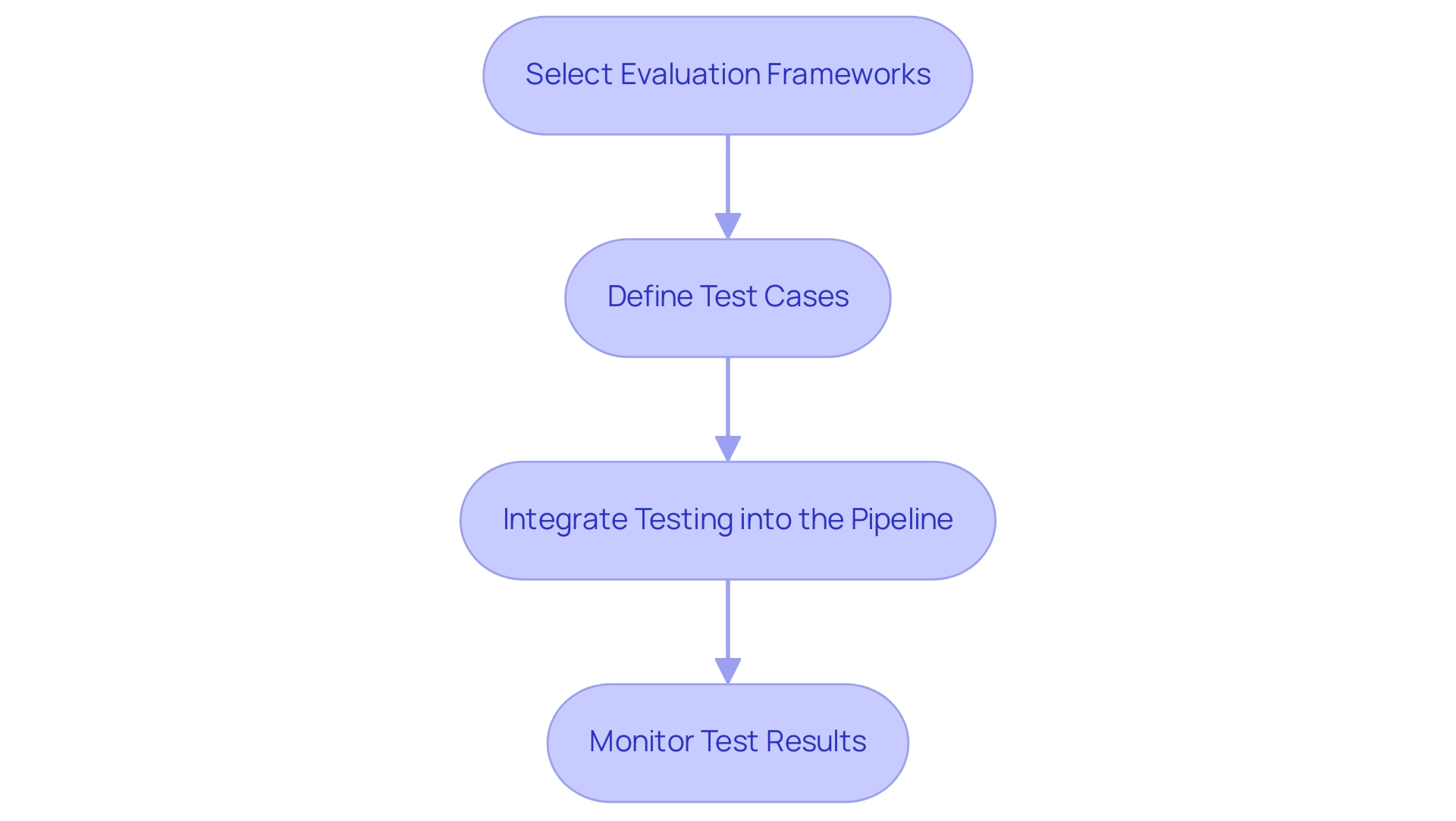
Conclusion
The integration of Continuous Integration (CI) and Continuous Deployment (CD) practices is essential for organizations striving to enhance their software development processes. By streamlining workflows through automated testing, efficient code management, and robust deployment strategies, companies can significantly improve software quality and delivery speed. Each stage of the CI/CD pipeline—from source code management to post-deployment monitoring—plays a critical role in ensuring that software not only meets quality standards but is also delivered reliably to end-users.
Choosing the right tools and following best practices is paramount in establishing a successful CI/CD pipeline. Organizations are encouraged to:
- Automate processes
- Maintain simplicity
- Foster a culture of frequent code commits to minimize integration issues
Furthermore, integrating automated testing into the development process is crucial for bolstering software reliability and reducing defect rates. By regularly monitoring performance metrics and optimizing workflows, teams can ensure that their CI/CD practices are both effective and aligned with long-term strategic goals.
In conclusion, as the landscape of software development continues to evolve, embracing CI/CD methodologies will empower organizations to stay competitive and agile. By understanding the intricacies of these pipelines and implementing best practices, companies can not only enhance their operational efficiency but also deliver high-quality software that meets the demands of an increasingly dynamic digital environment. Now is the time to prioritize CI/CD adoption to secure a successful future in software development.




